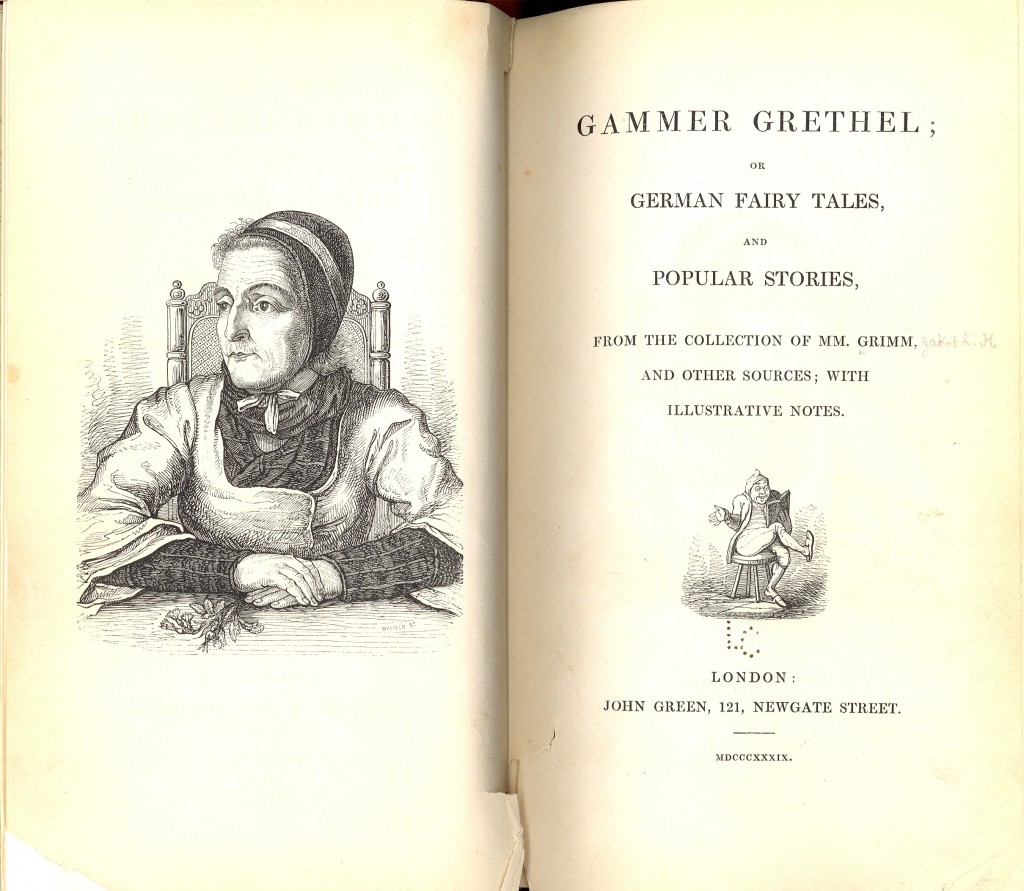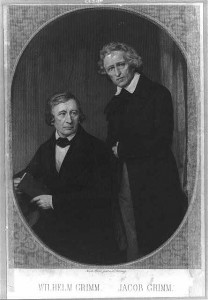Today marks the 200th anniversary of the publication of the first volume of Jacob and Wilhelm Grimm’s Children’s and Household Tales (Kinder-und Hausmärchen), popularly known as Grimms’ Fairy Tales.
The collection’s bicentennial has already been marked by the publication of a new retelling of fifty of the tales by His Dark Materials author Philip Pullman (Fairy Tales from the Brothers Grimm: A New English Version), as well as the release of a Bicentennial Edition of The Annotated Brothers Grimm by Maria Tatar. They are but the latest among hundreds of English-language editions available to readers, many of which can now be found online.
The Tales were first translated into English as German Popular Stories in two volumes by Edgar Taylor in 1823 and 1826. Taylor’s updated, single-volume edition of the tales, titled Gammer Grethel; or German German Fairy Tales, and Popular Stories, was published in 1839. This first single-volume edition of the Tales published in English forms part of the Library of Congress’s General Collections.

Frontispiece and title page, _Gammer Grethel; or, German Fairy tales, and Popular Stories_ (London: J. Green, 1839). Library of Congress copy.
The “Gammer Grethel” of the edition’s title is a mythologized version of Dorothea Viehmann, the wife of a village tailor near the German town Cassel, who contributed 35 of the 210 tales that appear in the authoritative seventh and final edition (1857) of Children’s and Household Tales. Taylor notes in the introduction:
Our Gammer Grethel, the supposed narrator of the stories, in fact lived, though under a different name. She was the Frau Viehmännin, the wife of a peasant in the neighbourhood of Hesse-Cassel; and from her mouth a great portion of the stories were written down by MM. Grimm.
The figure of Gammer Grethel allowed Taylor to construct a unique organizing principle for the edition. According to Taylor’s fictional narrative, the stories in the book were told to him directly by Gammer Grethel, who recounted them for twelve successive nights beginning on Christmas Eve. The arrangement of the books, which is divided into twelve “Evenings” (“Evening the First,” “Evening the Second,” etc.) reflects the order in which the tales were told to him each night.
The twelve-evening arrangement of the book recalls the Twelve Days of Christmas, and several of Grimms’ tales take place near Christmas or in the winter months. Of these, my favorite tale to read as a child, with the possible exceptions of “The Star Talers“—of which Hans Christian Anderson’s “The Little Match Girl” is a much better-known variant—is “The Elves and the Cobbler,” often known in English as “The Elves and the Shoemaker,” or simply “The Elves.” I still remember reading this story when I was about five years old and assuming that the elves, steadfastly making shoes from leather left out by the shoemaker each night, must have been sent by Santa Claus, since any elves involved in gift-giving missions clearly must be Santa’s emissaries! I also was struck, perhaps for the first time, by the odd idea that people can take as much joy in giving presents as in receiving them, a sentiment that certainly resonates more with with me now than with my five-year-old self.
If you have a favorite tale of the Brothers Grimm, please join us in celebrating the enduring legacy of the Tales by letting us know what it is in the comments. In the meantime, on behalf of the Poetry and Literature Center I wish everyone a very Grimm holiday season!


